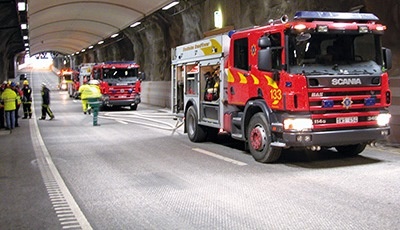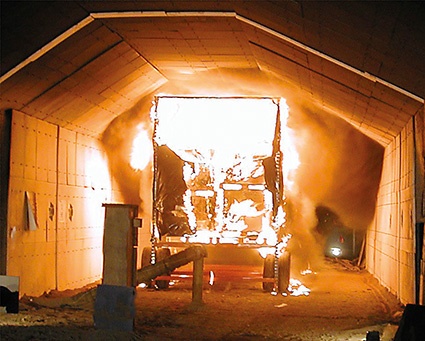Tunnel Vision: A Smarter Route to Tunnel Safety
In 1999, 39 persons died in a major fire in the Mont Blanc tunnel. While aiming for high levels of tunnel safety, it is also important to make best use of public resources. Society...


In 1999, 39 persons died in a major fire in the Mont Blanc tunnel. While aiming for high levels of tunnel safety, it is also important to make best use of public resources. Society demands a high level of safety, but not at any cost whatsoever. Scientists from Lund and Borås have taken up the challenge to develop a new structure for fire safety in tunnels.
A number of horrific tunnel fires occurred in Europe around the turn of the 2000s. A heavy goods vehicle carrying flour and margarine caught fire in the Mont Blanc tunnel on the morning of 24 March 1999. The fire grew quickly, and the driver was forced to abandon his vehicle without being able to extinguish the fire. The fire spread to several other vehicles, and took over 50 hours to be brought under control. 39 people died. The accident required expensive and time-consuming repairs, with the result that the tunnel was closed for three years. Goods and passengers had to take long diversionary routes and spend time in queues. The social, political and economic consequences were severe. As a consequence, legislation on minimum safety requirements in road tunnels in the EU was produced as an attempt to control the risk of tunnel fires. This in turn has resulted in the publication of Swedish legislation on fire safety.
For many years, scientists at SP in Borås and at Lund University have been working on fire safety in tunnels. Two years ago, the group was asked by the Swedish Transport Administration, which is responsible for most of the road tunnels in Sweden, to formulate a new framework for fire safety in tunnels.
Since 1995, the Swedish Transport Administration (or the National Road Administration as it then was) has applied a technical description of how a road tunnel must be constructed. New editions were published in 1999, 2004 and most recently in 2011. The main aim, of course, is that a tunnel must be safe. Society requires a high level of safety, but not at an unlimited cost. The following four principles provide guidance on how such balances might be achieved: risks that could be eliminated by reasonable means must be dealt with; major catastrophes must be avoided; public resources must be applied where they are most useful; and risks should be in proportion to benefit.
A Choice of Approach
A basic prerequisite for new guidelines for fire safety in tunnels is that Swedish legislation must be applied. This sets the minimum acceptable level of safety. The guidelines can then be designed in a number of different ways: they can, for example, be prescriptive in terms of details, or be more performance-based. Prescriptive specification has the drawback that costs for some tunnels can become unreasonably high, or that what might be better solutions cannot be applied as they conflict with the detailed specifications.
On the other hand, if the performance of a tunnel is determined by performance-based objectives, it is possible to encounter other problems. Demonstrating that required performance has actually been fulfilled is more difficult than following a detailed design approach. This means that performance requirements must be formulated so that they are clear and so that it is possible to verify them.
In its work, the group of scientists proposes a hybrid of prescriptive requirements, approvable solutions, and performance-‑based requirements. The new Building Regulations in Sweden present an example of this approach: starting from existing legislation, they express both prescriptive and performance requirements and acceptable solutions for fire safety. An approved design can be achieved in two ways: by following the approvable solutions or by showing that the performance requirements have been fulfilled. All prescriptive requirements have to be fulfilled. In this respect, the group has attempted to reflect the regulatory structure for buildings so that hopefully the sector can recognize itself.
The work can be divided into two parts: specification of requirements and verification. The first part, starting from existing legislation, is concerned with specifying fire safety requirements for tunnels. In turn, these requirements can be divided into overall and subsidiary requirement levels. The proposed framework has a total of six overall requirements, or basic requirements. Five of these basic requirements are general requirements that apply to the construction sector as a whole.
Lessons to Be Learnt
One of these five basic requirements is concerned with the ability to escape. In the Mont Blanc fire, evacuation failed very badly, with many persons dying in their vehicles. The danger was not made apparent to them. One lesson in this respect is the importance of clear instructions for those using the tunnel in respect of evacuation, e.g. through the use of loudspeakers and information signs.
Another basic requirement is concerned with the prevention of the spread of fire. In the Mont Blanc accident, the fire spread to several goods vehicles. This can be prevented by such means as transverse ventilation, immediately extracting hot fire gases. Another way of limiting the fire and its spread is the use of a fixed extinguishing system in the tunnel, which has the dual effect of cooling both the fire and adjacent targets.
The Mont Blanc tunnel had a transverse ventilation system. Unfortunately, however, the system had inadequate capacity and was wrongly used, with the result that the fire was able to spread over hundreds of meters between the vehicles. This lesson illustrates the importance of organizational fire protection and of ensuring that systems actually work in practice. In the case of buildings, this corresponds to systematic fire protection work. This is even more important in tunnels, as shown by the number of items of legislation that relate to the requirement.
As opposed to an ordinary building, a tunnel has vehicles passing through it. In this respect, a tunnel is more similar to a process industry. The process of flowing vehicles can be interrupted at any time. Requirement group no. 6 deals with managing the flow of vehicles. This includes dealing with accidents in an effective manner to prevent them escalating. The Mont Blanc fire revealed major shortcomings in how the rescue service and the tunnel control technicians dealt with the accident, underlining the importance of training exercises and having a well‑trained and informed organization.
Proving the Theory
Part two of the work of preparing a new target standard is concerned with verification, i.e. showing that a tunnel meets the requirements. This can be done in two ways: either by complying with the provable design solutions that have been specified or by showing that the tunnel meets specified performance-based requirements.
To show, for example, that the requirement in respect of evacuation has been fulfilled, it can be appropriate to comply with the specified approval solutions. One such approvable design requirement is not to exceed a certain maximum distance between evacuation doors. However, if the conditions necessitate some other solution, it must instead be demonstrated that the design meets the performance requirement.
In this case, the performance-based requirement is that everyone should be able to evacuate before critical conditions, such as reduced visibility, arise. Fulfillment of performance-based requirements by a particular design arrangement can be verified by a scenario analysis, which is something that is already employed in the construction sector. A scenario analysis postulates a number of plausible accident scenarios that must achieve the performance-based requirements. Computer simulations and calculations evaluate the consequences which, for an approved tunnel, must fulfill the performance-based requirements.
Train for the Future
Prescriptive requirements, such as training and exercises, can be fulfilled in only one way, as demonstrated very clearly by the Mont Blanc fire. This particular requirement can be fulfilled only by regular training and exercises.
A tunnel is regarded as being sufficiently safe if it meets the framework requirements. The combination of prescriptive requirements, performance requirements and approvable solutions provides flexibility in respect of how the solution is designed and provided. Solutions can vary, depending on the conditions. Hopefully, this work will result in the production of a clear and simple process, bringing together innovations and an efficient use of resources, while at the same time meeting the overall requirement for safety. A further target is to avoid catastrophes such as the Mont Blanc tunnel fire in the future.
Business Partner
SP Technical Research Institute
Germany
most read

The Benefits of AI-based Video Surveillance Solutions for Sports Venues
Dallmeier Interview: Artificial intelligence Makes Stadiums Smarter

GIT SECURITY AWARD 2026 - The winners have been announced!
GIT SECURITY AWARD 2026: The best safety and security solutions of the year - now an overview of all winners

Five Questions with Intersec Saudi Arabia Exhibition Director Riham Sedik
Intersec Saudi Arabia 2025: Exclusive Insights with Riham Sedik, Exhibition Director

Machine & plant safety: The winners of category A at the GIT SECURITY AWARD 2026
GIT SECURITY AWARD 2026: Machine & plant safety - an overview of the most innovative solutions











